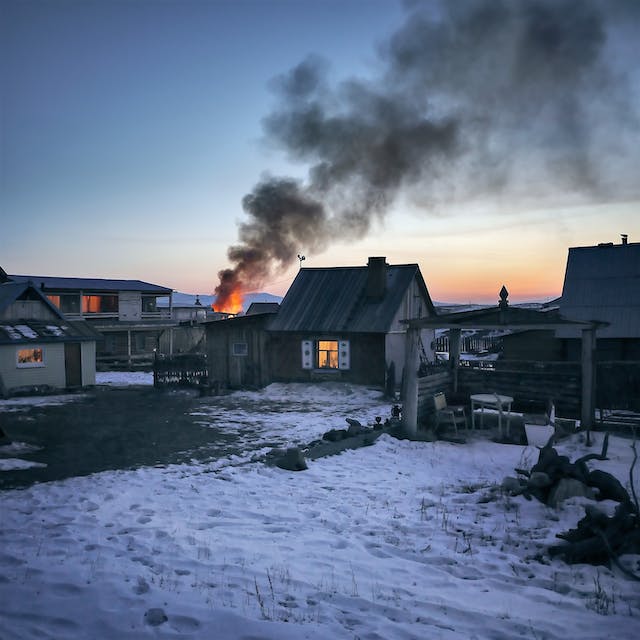
Chimney fires are a serious threat to the safety of your home and those inside it. Understanding the common causes of chimney fires is essential for taking proactive measures to prevent these potentially devastating incidents. In this article, we’ll explore 30 factors that contribute to the occurrence of chimney fires.
1. Creosote Buildup:
The leading cause of chimney fires is the accumulation of creosote, a highly flammable byproduct of combustion that adheres to the interior of the chimney lining over time.
2. Infrequent Chimney Cleaning:
Neglecting regular chimney cleaning allows creosote to accumulate, increasing the risk of a chimney fire. Annual inspections and cleanings are crucial for maintaining a safe chimney system.
3. Burning Unseasoned Wood:
Wet or unseasoned wood produces more creosote during combustion. Use only well-seasoned firewood to reduce creosote buildup and minimize the risk of chimney fires.
4. Overloading the Fireplace:
Burning excessive amounts of wood at once can lead to high temperatures and an increased production of creosote. Use a controlled amount of firewood to avoid overloading the fireplace.
5. Faulty Masonry:
Cracks or gaps in the masonry of the chimney can allow sparks and embers to escape, potentially igniting nearby combustibles and causing a fire.
6. Missing or Damaged Chimney Caps:
Chimney caps serve as protective barriers, preventing debris, animals, and rainwater from entering the chimney. Missing or damaged caps expose the chimney to potential fire hazards.
7. Improperly Sized Chimney:
An improperly sized chimney can lead to poor draft, incomplete combustion, and increased creosote buildup. Ensure your chimney is correctly sized for your heating appliance.
8. Cracked Chimney Liner:
A cracked or deteriorating chimney liner can allow flames and heat to reach combustible materials surrounding the chimney, increasing the risk of a fire.
9. Using Improper Fuels:
Avoid using accelerants, such as gasoline or kerosene, to start a fire. Improper fuels can lead to uncontrollable flames and pose a significant fire hazard.
10. Lack of Spark Arrestor:
Chimneys without spark arrestors allow sparks and embers to escape, potentially igniting nearby flammable materials.
11. Ignoring Warning Signs:
Unusual odors, sounds, or visible signs of smoke during fireplace use may indicate a problem. Ignoring these warning signs increases the risk of a chimney fire.
12. Using Wet or Damp Wood:
Burning wet or damp wood leads to inefficient combustion, increased creosote production, and heightened fire risk.
13. Blockages in the Chimney:
Blockages, such as bird nests or debris, restrict airflow and increase the likelihood of chimney fires. Regular inspections can identify and address blockages promptly.
14. Malfunctioning Dampers:
Dampers regulate airflow in the chimney. Malfunctioning dampers can lead to poor combustion and increased creosote buildup.
15. Damaged Flashing:
Flashing seals the intersection between the roof and the chimney. Damaged flashing allows water to enter, potentially causing damage that leads to a chimney fire.
16. Using Softwoods Exclusively:
Softwoods, such as pine, produce more creosote than hardwoods. A diet of exclusively softwoods increases the risk of chimney fires.
17. Lack of Chimney Insulation:
Insufficient insulation allows heat to transfer to combustible materials surrounding the chimney, contributing to the risk of fire.
18. Smoking Chimney:
A smoking chimney indicates poor draft and incomplete combustion. Addressing smoking issues promptly helps prevent creosote buildup and chimney fires.
19. Absence of Fireproof Barrier:
Wood framing or other combustible materials too close to the chimney may pose a fire risk. Ensure the presence of a fireproof barrier to protect surrounding structures.
20. Ignoring Manufacturer Guidelines:
Follow the manufacturer’s guidelines for your heating appliance, chimney components, and installation. Deviating from these recommendations can increase the risk of chimney fires.
21. Corrosion of Chimney Components:
Corrosion weakens chimney components, making them more susceptible to damage and increasing the risk of fire.
22. Proximity to Overhanging Branches:
Overhanging branches pose a fire risk, especially if they come in contact with the chimney or sparks from the fireplace.
23. Poorly Constructed Chimney:
Chimneys constructed with subpar materials or improper techniques may lack the structural integrity needed to withstand high temperatures, increasing the risk of a fire.
24. Neglecting Chimney Sweeping:
Regular chimney sweeping removes creosote and prevents its buildup. Neglecting this essential task significantly increases the risk of chimney fires.
25. Lack of Chimney Inspection:
Annual chimney inspections identify potential issues before they escalate. A lack of inspections can lead to undiscovered problems and heightened fire risk.
26. Frequent Use Without Breaks:
Continuous, prolonged use of the fireplace without breaks can lead to overheating and increased creosote production. Allow the chimney to cool between uses.
27. Infrequent Use:
Chimneys may deteriorate faster when left unused for extended periods. Regular use helps maintain the chimney and reduces the risk of fire hazards.
28. Lack of Chimney Cap Maintenance:
Chimney caps require regular maintenance to function effectively. Neglecting this upkeep allows debris and animals to enter, posing fire risks.
29. Using Inadequate Venting:
Insufficient venting can lead to poor combustion, increased creosote buildup, and heightened fire risk. Ensure your chimney system has proper venting for optimal safety.
30. Improper Installation:
Chimney fires can result from faulty installation. Hire certified professionals to install and maintain your chimney system according to industry standards.
Conclusion:
Understanding the common causes of chimney fires empowers homeowners to take proactive measures in preventing these hazardous incidents. By addressing potential risks, practicing regular maintenance, and seeking professional guidance, you can enjoy the warmth of your fireplace while ensuring the safety of your home.
